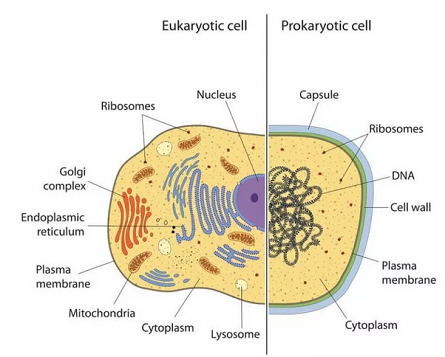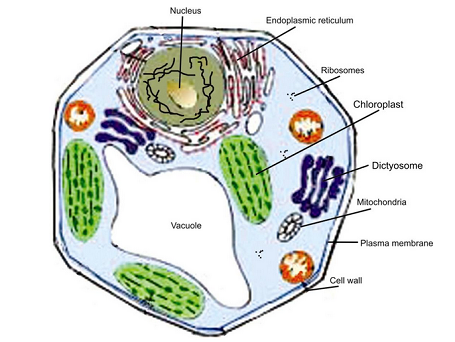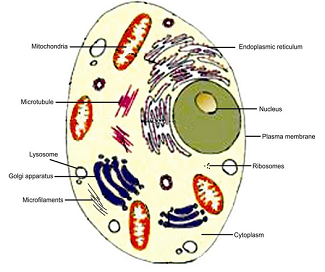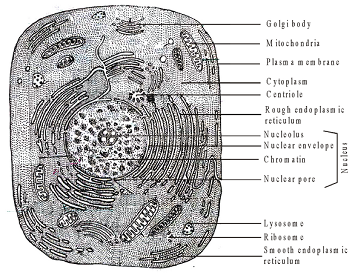TYPES OF CELL & ORGANISM
Cell of Class 9
Cell Volume
The volume of a cell :
- Is fairly constant for a particular cell type.
- Is independent of the size of an organism.
TYPES OF CELL & ORGANISM
On the Basis of Number of Cells Organisms can be categorized as:
(i) Unicellular organisms: These are organisms which made up of single cell only. This single cell .Performs all the vital body functions of an organism. e.g. Amoeba
(ii) Multicellular organisms: These are the organisms which made up of numerous cells. These cells then combine to form an organ and group of organs performing different functions forms an organ system which further forms an organism. e.g. plants and animals
On the basis of type of organization, cells are two types :
(i) Prokaryotic cells: these are primitive and incomplete cells. They have less developed nucleus withoutnuclear membrane & nucleolus. e.g. Bacteria.
(ii)Eukaryotic cells: these are well developed cells. They have advanced nucleus with unclear membrane and nucleolus. e.g. Plants & animals.
Differences between Prokaryotic cells and Eukaryotic cells
|
S.No. |
Prokaryotic cell |
Eukaryotic cell |
|||
|
1. |
Size |
0.1-5 μm |
5-100 μm |
||
|
2. |
Intracellular compartmentalization |
One envelope system |
Two envelope system |
||
|
3. |
Cell wall |
If Present, containing mucopeptide or peptidoglycan. |
If present contains cellulose, no peptidoglycan |
||
|
4. |
Nucleus |
Typical nucleus is absent, instead nucleoid or genophore is present |
Typical nucleus made of nuclear envelope, chromatin, nucleoplasm, nuclear matrix and nucleoli. |
||
|
5. |
Occurrence of chromosome |
Nucleoid is equal to a single chromosome called pro-chromosome |
Nucleus contain chromatin material of two or more chromosomes |
||
|
6. |
DNA |
1. |
DNA lies freely in cytoplasm |
1. |
In eukaryotic cell DNA lies inside nucleus, mitochondria and plastids |
|
2. |
DNA is generally circular |
2. |
DNA is commonly linear but circular in mitochondria and plastids |
||
|
3. |
DNA is naked (without histone proteins) |
3. |
DNA is associated with histones |
||
|
4. |
DNA content is low |
4. |
DNA content is comparatively high |
||
|
7. |
Plasmids |
Plasmids may occur |
Plasmids rare |
||
|
8. |
Cell membrane |
1. |
It is folded to form mesosomes |
1. |
Mesosome is absent |
|
2. |
Cell membrane is involved in separating replication products. |
2. |
Such separating function of cell membrane is absent. |
||
|
9. |
Flagella |
1. |
Smaller, 4-5 μm × 12 nm |
1. |
Longer, 150 μm × 200 nm |
|
2. |
Single stranded |
2. |
11 stranded |
||
|
3. |
No distinction of Axoneme and sheath |
3. |
Clear distinction of Axoneme. |
||
|
10. |
Cyclosis |
Cytoplasmic movement absent |
Cytoplasmic movement present |
||
|
11. |
Sap vacuoles |
Absent |
Present |
||
|
12. |
Gas vacuoles |
It may present to provide buoyancy and protection against intense radiation. |
No gas vacuole |
||
|
13. |
Endocytosis and exocytosis |
Absent |
Present |
||
|
14. |
Endoplasmic reticulum |
Absent |
Present |
||
|
15. |
Ribosomes |
1. |
70S type |
1. |
80S type |
|
2. |
Occur freely in cytoplasm as well as attach to plasma lemma |
2. |
In cytoplasm these occur freely as well attached to endoplasmic reticulum. Also found in mitochondria and plastids. |
||
|
16. |
Mitochondria |
Absent |
Present |
||
|
Respiratory enzymes are attached to plasma membrane |
Respiratory enzymes are present in cytoplasm and mitochondria |
||||
|
17. |
Golgi apparatus |
Absent |
Present |
||
|
18. |
Thylakoids |
If present, lie freely in cytoplasm |
These occur inside chloroplast |
||
|
19. |
Lysosomes, phaerosomes, glyoxysomes. |
Absent |
Present |
||
|
20. |
Centrosome |
Absent |
Present except in plants. |
||
|
21. |
Microtubules and microfilaments |
Rarely present |
Usually present |
||
|
22. |
Sexual reproduction |
Usually absent |
Commonly present |
.png)
|
A. Blue Green Alga |
B. Bacterial Cell |
|
Example of Prokaryotic cells |
|
|
|
An Eukaryotic Cell

Differences between Animal and Plant Cell
|
S.No. |
Animal cells |
Plant cells |
|
|
1. |
Presence of cell wall |
Absent, thus cell shape is not firmed. |
Present that’s why shape is firmed |
|
2. |
Presence of tissue fluid |
Tissue fluid generally bathes the cells. |
Absent |
|
3. |
Occurrence of protoplasm |
Protoplasm fills the whole cell |
Protoplasm is peripheral. |
|
4. |
Vacuoles |
Contains many small vacuoles |
Contains a large central vacuole |
|
5. |
Nucleus |
Usually rounded, lies in centre |
Usually oval, lies in peripheral cytoplasm. |
|
6. |
Cell anchorage |
Cells are held together by various types of junctions. |
In plants, cells held together by middle lamella. |
|
7. |
Plastids |
Absent |
Present |
|
8. |
Reserve food |
Glycogen |
Starch |
|
9. |
Mitochondria |
Comparatively more in number, its cristae are plate like. |
Comparatively fewer, cristae are tubular. |
|
10. |
Golgi apparatus |
It is commonly a single complex. |
It is made of a number of distinct units called Dictyosomes. |
|
11. |
Centrosome |
Present |
Absent except in some lower forms |
|
12. |
Lysosomes |
Present |
Absent |
|
13. |
Cell division method |
Cleavage furrow method |
Cell plate method |
|
14. |
Bio synthesis of materials |
Animal cells are unable to synthesized amino acids, vitamins and coenzymes required by it. |
Plant cells can synthesize all material required by them. |
|
15. |
If kept in kept in hypotonic solution |
Animal cells burst when kept in water or hypotonic solution. |
When placed in hypotonic solution or water these swell up (but do not burst) |

Ultrastructure of a generalized plant cell

Ultrastructure of generalized animal cell

- CELL STRUCTURE
- HISTORICAL BACKGROUND OF CELL
- Cell structure and function
- TYPES OF CELL & ORGANISM
- DETAILED STRUCTURE OF CELL
- CELL MEMBRANE
- CELL WALL
- PROTOPLASM
- NUCLEUS
- CYTOPLASM
- ENDOPLASMIC RETICULUM
- GOLGI APPARATUS
- LYSOSOMES (ENZYMES PACKETS)
- MITOCHONDRIA
- RIBOSOMES
- PLASTID
- VACUOLES (NON-CYTOPLASMIC INCLUSIONS)
- PEROXISOMES
- CELL DIVISION
- solved question
- Exercise 1 for Cell of class 11
- Exercise 2 for Cell
- Exercise3 for Cell of class 11
- Exercise 4(Fill in the blanks) for Cell of class 11
- Exercise 5(True-False) for Cell of class 11










